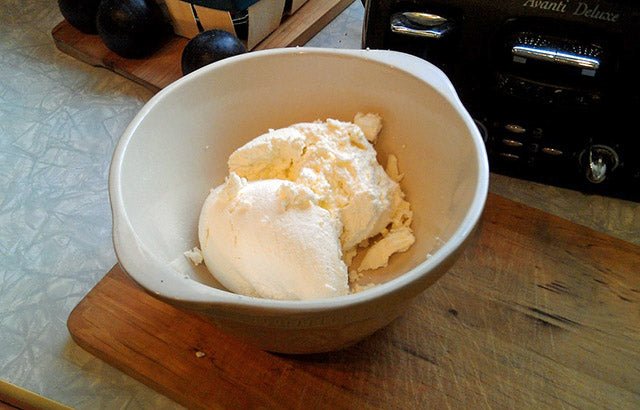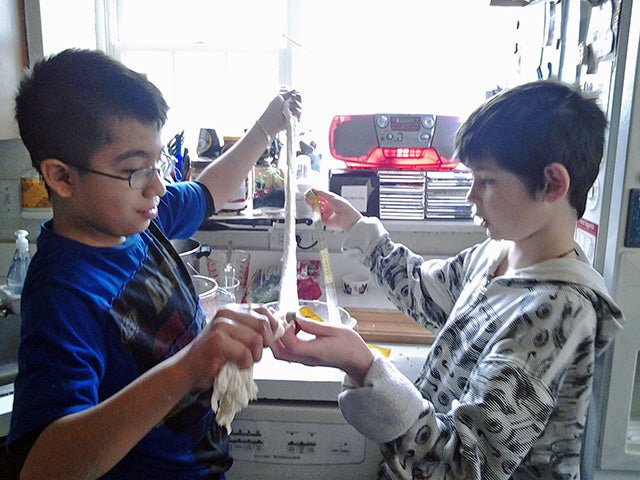 |
| Ryys in Stockholm |
Made by a Norwejian who was inspired by a Pole …
Dr. Rhys Evans lives in Norway and he loves good food. So, he cooks a lot from healthy ingredients and he has begun his own food blog called Eating Well is the Best Revenge. (Revenge from the everyday insults of life!)
A asked him how he got started making cheese:
I got into making cheese obliquely because I am into making food from scratch, using wholesome ingredients, myself. I find it rewarding, therapeutic and just downright satisfying. I make sausages, smoke my own fish, make my sauces, pickles, etc.
One of the great things about being here in Europe is that there is a strong legacy amongst the older generations of making their own food, from garden to plate, often with preserving in between. As an academic, in fact, I am hoping to start a Europe-wide research project which finds these national treasures, honors them and makes what they can teach us available to the wider population.
More directly, as it says in the blog, a Polish friend of mine was reminiscing about how his mom use to make curd cheese. Which reminded me of how, back in the early seventies, I used to share a cow with some neighbors in the Slocan Valley in BC. We used to make curd cheese by simply leaving some milk on the warming shelf of the wood stove until it curdled and then hanging the results over the sink overnight. I loved that curd cheese on toast in the morning! So, I was inspired!
Now, here in Norway, I work with farmers and rural development and have bought my first cheese making starter kit from you guys. Today curd cheese, tomorrow the world!
 |
| Convenor of the Equine Research Network (EqRN) |
Home Made Curd Cheese
By Dr. Rhys Evans at Eating Well is the Best Revenge
I named this page “Hjeme brukt” (I guess I could have also named it “Hjeme laget”) in honor of the wonderful norsk dairy product, “Kultur Mjolk” — ‘cultured milk.’ Kulturmjolk is slightly soured milk which is something like what you would get if you left raw milk in the fridge for three or four days, or out of the fridge overnight. One of the cheeses I enjoy making is Raclette cheese, which has a rich history in Alpine cuisine. Its fascinating how this cheese, known for its melting qualities, is not only a culinary delight but also part of the tradition of preparing food at the table, much like the homemade dishes I create. The ‘culture’ is reminiscent of Kifir, or even Greek Yoghurt, but it pours and drinks just a little thicker than milk. And as it says on the carton, “Eit Reint Naturprodukt drukke av Stolt Nordmenn i generasjonar” — or, A real natural product drunk by proud Norwegians for generations. I haven’t seen anything quite like it in the anglo world at all. Sour cream is much thicker. And buttermilk is very artificial and has butter added to it. On a recent visit to California I looked for alternatives, but couldn’t find any.
What is great about using it for making curd cheese is that it is already cultured, so you can go straight from the carton to the cheesecloth!
So here’s to Kulturmjølk!
Now most of my friends can’t get kulturmjolk, so what is to be done? My best guess is that you can culture milk yourself with a bit of Greek Yoghurt, or Kifir mixed with ordinary milk. It won’t take much. Just mix together and leave overnight. The result should be a little thicker, and have that slightly ‘sour’ taste — not ‘bad’, but definitely not ‘sweet.’
And if you can’t make it work, there is always the New England Cheese Company who have a world of wonderful cultures, cheesemaking kits and even a blog and Facebook page! They have even inspired me to start making other cheeses — watch this space! You can find them here.
The recipe comes, btw, from my good friend Rafal Ziolkowski. His momma used to make this in Poland when he was a kid. If I remember right, he had already tried it and just said, “here’s what you do, its easy!” And it is!!
And now I make it every week. I get much more curd cheese out of two litres (quarts) of kulturmjolk than I would in a small pack of cream cheese, for the same price. Plus this is better! I use it on sandwiches with last night’s cooked salmon (even the teriyaki salmon!), I stuff peppers with it, and I make an excellent Russian pancake called Sirniki with it (I’ll put that recipe up soon!).
Making the cheese
Ok, so all I do is fill a large sauce pan with hot water and get it boiling. I put the two litre packages of kulturmjolk in it and turn the element off. I then leave it on the element until cool.
That’s all. I don’t open them (I’ve never had one burst) or anything. Plop them in and turn the electric element off. I suppose if I was using gas, I would let them boil for five minutes, and then turn it off.
Then I remove them from the pan and prepare a colander with some cheese cloth draped in it. You have to be careful to get the cloth to overhang the edges all the way round and put it in so that when you pour the milk in, the clothe doesn’t fall down and you lose your curds.
Using a serrated knife, I simply cut the tops off….
And pour the contents into the cheese cloth.
There is just enough room in my colander to fit the contents of both boxes.
Although these aren’t the best of pix, you can clearly see the curds, and the whey (liquid) above. So the whole purpose of the next 12 hours or so is to get them separated. I let the colander sit in the sink for an hour or so, by which time it drains down to look like this, below.
At this point I take it out of the sink and tie the corners of the cheese cloth over a long wooden spoon. This I hang over the sink overnight. And usually I twist the resulting bag to squeeze out excess whey. How much you do this comes with experience. In fact, every batch is slightly different — some wetter, some drier. You just have to make a judgement call and see how it goes.
Here, below is the result the next morning. It is a bit damp, but ok. You can see the curdy texture which marks it as curd cheese, or quark, or ‘farm cheese.’ Basically there are a lot of names for the same thing because this is something peasant farmers who had cows or goats (or sheep) did all over the world.
And there is only one final step to go! I put the curds in a bowl and add some salt (usually about a half a teaspoon). Then I take a paddle and work it for about a minute to smooth it out a little whilst mixing in the salt. If it is a little dry, I add a dollop of cream (not too much), or if I like the texture, I leave it as it is.
And that is it! It is ready to enjoy! So easy and simple.
Now, talking to my buddy Raf, again, he said that his mother put it through a meat grinder sometimes to make it smoother, more like cream cheese. And on the next linked page, you can see what I did to try that out. But generally, this is as far as I take it. I just pop it in the fridge and it usually lasts about a week, covered.
More on Curd Cheese
My buddy Raf mentioned that his mother used to process the curd cheese she made in a meat grinder to make it smoother. So I thought I would have a try.
I took my trusty Kenwood Kitchen Machine and used the meat grinding/sausage making attachment. (Btw, watch these pages for my adventures with sausage making…..)
The process was fairly simple. I used the finest of the three grinding meshes and ran the curd cheese through it twice.
Because the batch of cheese was not so large, an issue arises about all the cheese left in the worm screw inside the sausage attachment. To deal with this on the second run, I took some stale bread and sliced it into chunks. When done with the cheese I stuffed the croutons into the attachment and ran them through, watching carefully for when the bread actually made it out of the mincer. At that point I stopped, so as not to contaminate the processed cheese.
And the result was pretty good! Definitely not Philadelphia Cream Cheese, but much smoother and nice to spread.
Enjoy!





























































































































































